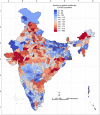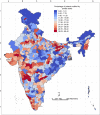TB notification rates across parliamentary constituencies in India: a step towards data-driven political engagement
- PMID: 33715264
- PMCID: PMC8360195
- DOI: 10.1111/tmi.13574
TB notification rates across parliamentary constituencies in India: a step towards data-driven political engagement
Abstract
Objective: National averages obscure geographic variation in program performance. We determined Parliamentary Constituency (PC)-wise estimates of TB notification to guide political engagement.
Methods: We extracted district-level TB notification data from the 2018 annual TB report. We derived PC-level estimates by building a 'cross-walk' between districts and PCs using boundary shapefiles. We described the spatial distribution of the PC-wise estimates of Total Notification Rate and percentage of Private Sector Notification.
Results: The median PC-wise Total Notification Rate was 126.24/100 000 (IQR: 94.86/100 000, 162.22/100 000). The median PC-wise Percentage Private Sector Notification was 18.03% (IQR: 9.56%, 26.84%). Only 16 (2.94%) PCs met the target of 50% private sector notification. Most of high notification rates in PCs were driven by high notification in public sector. There was geographic - both interstate and within state inter-PC - variation in the estimates of these indicators. The study identified some geographic patterns of notification - high positive outlier PCs with adjoining PCs in lower deciles of notification rates, intra-state differences in PC performance, and similarities in notification rates of adjoining PCs in different states.
Conclusion: In addition to regional inequality, the study identified geospatial patterns that can aid in the formulation of suitable interventions. These include decongestion of overburdened facilities by strengthening poorly performing units. The PCs with a high percentage Private Sector Notification can act as role models for neighbouring PCs to improve private sector engagement. MPs can play a crucial role in mobilising additional resources, creating awareness, and establishing inter-PC and inter-state collaboration to improve TB program performance.
Keywords: Geographic Information System (GIS) mapping; TB elimination; political commitment; regional variation.
© 2021 The Authors Tropical Medicine & International Health Published by John Wiley & Sons Ltd.
Figures








References
-
- World Health Organization . The End TB Strategy. World Health Organization: Geneva, 2015.
-
- Central TB Division, Ministry of Health and Family Welfare . India TB Report 2020: National Tuberculosis Elimination Programme Annual Report. Nirman Bhawan, New Delhi – 110011: Central TB Division, Ministry of Health and Family Welfare (Available from https://www.tbcindia.gov.in/showfile.php?lid=3538) [10 Oct 2020]
-
- Indian Council of Medical Research, Public Health Foundation of India, Institute for Health Metrics and Evaluation . India: Health of the Nation’s States – The India State‐level Disease Burden Initiative. ICMR, PHFI, and IHME: New Delhi, India, 2017.
-
- Reserve Bank of India . Per Capita Net State Domestic Product (Current Prices). Reserve Bank of India (Available from: https://rbidocs.rbi.org.in/rdocs/Publications/PDFs/T_15663205AC20DE42E18...) [18 Nov 2020].
Publication types
MeSH terms
Grants and funding
LinkOut - more resources
Full Text Sources
Other Literature Sources
Medical
Miscellaneous

